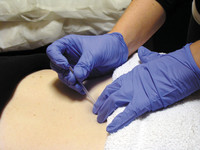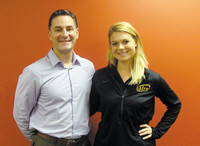I never meant to, but the second the thin, monofilament needle went into my lower back, my whole body twitched/ As it turns out, that’s a good thing because I then felt my muscle slowly unravel …
This item is available in full to subscribers.
We have recently launched a new and improved website. To continue reading, you will need to either log into your subscriber account, or purchase a new subscription.
If you are a current print subscriber, you can set up a free website account by clicking here.
Otherwise, click here to view your options for subscribing.
Please log in to continue |
|


I never meant to, but the second the thin, monofilament needle went into my lower back, my whole body twitched/ As it turns out, that’s a good thing because I then felt my muscle slowly unravel after a day of being tied up like a Christmas bow. After a sports injury from years ago, my back can sometimes clamp up. Through my brief dry needling experience with Elite Physical Therapy in Cranston I could truthfully say my lower back pain had subsided.
– Kelcy Dolan
Dry needling is a fairly new, modern and safe treatment in which small “dry” needles, without fluid or medication, are inserted into “trigger points,” knotted muscles, tendons or ligaments near nerves, in an attempt to relieve musculoskeletal and neuromuscular conditions, decreasing pain and increasing motion or certain areas of the body. The American Physical Therapy Association (APTA), a national professional organization for physical therapists across the country, supports dry needling.
Two months ago, 15 of Elite Physical Therapy’s clinicians received training in dry needling. Certification requires three three-day courses, and those clinicians will receive their certification in January but are trained to administer the treatment to patients.
Julia Milner, DPT, MTC, Cert. DN, and director of Elite Physical Therapy in Cranston, said that dry needling is not acupuncture. Where acupuncture follows traditional Chinese beliefs and looks to realign “Qi,” dry needling is backed by science addressing specific chronic pain at its source alongside typical physical therapy.
Michael Nula, founder of Elite Physical Therapy, said in only a couple of months more than 100 clients have looked to dry needling, seeing long-term results with nearly immediate pain relief.
Milner said five to 10 patients weekly receive dry needling treatment.
“It’s a popular treatment and we hope to stay at this pace of growth,” Nula said. “We want to stay current keeping up with the latest and greatest treatments especially when we are having such phenomenal and fast early results so we can be ready for anything that comes through the door.”
He admitted that this isn’t a “cure all, end all,” but it is one more way Elite Physical Therapy can serve their clients.
Nula began Elite Physical Therapy in 2002, opening his first location in Warwick. After going through physical therapy due to a knee injury in high school, Nula knew he wanted to go into physical therapy ensuring patients received one-on-one care and individualized treatment plans for the best results for each individual.
Now, there are 92 employees, 42 of them clinicians and seven locations across the state. Each site is equipped with the capabilities to administer dry needling. Nula aims to have employees trained and certified in the procedure.
“We are trying to get the body right and healthy,” Nula said. “You need to understand all the facets of an issue to get people moving again. There is no cookie cutter approach.”
Milner explained that although there has been a lot of science published on the effectiveness of dry needling, two dominant theories have arisen as to why. One idea is that the use of needles enables the desensitizing of a trigger, or the nerve causing the pain. It “twitches and fires,” then is able to relax, relieving the tightness and pain.
“Basically, the nerve just shuts up,” Milner said.
Similarly, dry needling can relieve pain in the cerebral cortex, inhibiting pain receptors.
Nula exampled a house alarm system. If the alarm is triggered closing a door or fixing a window won’t make the alarm stop sounding. Rather, you must go directly to the source to shut it off. Similarly, to stop pain you can stop the brain from giving off the signal for pain.
Milner said, “When you take someone’s pain away that is a powerful thing. It’s incredible for us as clinicians to get a patient to that point.”
Nula and Milner both noted that dry needling is especially good for those patients facing chronic pain and has even helped certain individuals decrease or even eradicate their pain medication use.
Nula said the “real power” of dry needling comes for those who have heavily relied on prescriptions to manage pain and after only a few sessions they don’t feel dependent on those medications.
“This is a more natural and healthy method for pain control,” he said. “Why add unnecessary medications, with possible harmful side effects, if you can combat that with a healthy and lasting solution?”
Nula said that most of the apprehension around dry needling is the idea that it may be painful, but assured that although there can be some tenderness and muscles may be a bit sore directly after a treatment, the procedure is not “torture” and isn’t painful.
Having experienced the treatment myself, each needle went in either completely unregistered or nothing more than a tiny pinch, less painful than a flu shot. The relief afterwards was well worth it.
Elite Physical Therapy has seven locations across the state, one in both Warwick and Cranston.
Currently, most insurances do not reimburse dry needling; however, they do provide both self-rate and pre-payment plans. Dry needling session are $75 per treatment, $350 for 5, $490 for 7 and $770 for 11.
The APTA is advocating and lobbying to have insurance companies cover dry needling.
For more information on Elite Physical Therapy or dry needling or to make an appointment call 737-4581 or visit their website www.elitephysicaltherapy.com.
For more information on APTA visit www.apta.org.
Comments
No comments on this item Please log in to comment by clicking here